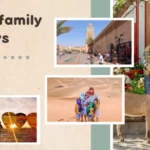Table of Contents
From the bustling souks of Marrakech to the blue city of Chefchaouen, Morocco feels a world away, but getting there is easier than you think. Whether you’re drawn to the golden dunes of the Sahara Desert, the architectural wonders of Fes, or the coastal charm of Casablanca, your Moroccan adventure begins with choosing the right route to this captivating North African destination.
Understanding how to get to Morocco efficiently can transform your travel experience from stressful to seamless. With multiple entry points and transportation options, from budget-friendly flights to scenic ferry crossings, there’s a perfect route for every type of traveler. Let’s explore the most practical and enjoyable ways to reach Morocco’s diverse landscapes and rich cultural heritage.

Quick Answer: How to Get to Morocco
The most popular way to get to Morocco is by plane, with major Morocco international airports in Marrakech (RAK), Casablanca (CMN), and Tangier (TNG). The second most common way is by ferry, primarily from southern Spain (Algeciras, Tarifa) to Tangier. Direct flights are available from most major European cities and select cities in North America and the Middle East.
Key Facts:
- Fastest Route: Flying (2-8 hours, depending on origin)
- Most Scenic: Ferry from Spain (1-2 hours crossing)
- Most Popular Airports: Marrakech, Casablanca, Tangier
- Visa Required: No visa needed for most tourists (90-day stays)
Getting to Morocco by Air: The Fastest Route
Flying to Morocco is the most efficient way for most international travelers to reach this enchanting destination. Morocco’s well-connected airport network and growing number of international partnerships make air travel increasingly accessible and affordable. The country’s strategic location between Europe and Africa positions it as a natural gateway, with multiple daily flights from major global hubs.
Morocco International Airports (A Comparison Table)
Understanding Morocco’s airport landscape helps you choose the best entry point for your specific itinerary and interests:
| Airport | Code | Best For | Key Airlines |
|---|---|---|---|
| Marrakech-Menara | RAK | Tourism, Atlas Mountains, Souks | Ryanair, easyJet, Royal Air Maroc |
| Casablanca Mohammed V | CMN | Business, Layovers, Capital City | Royal Air Maroc, Air France, Emirates |
| Tangier Ibn Battouta | TNG | Ferry connections, Northern Morocco | Ryanair, Vueling, Iberia |
| Fes-Saïss Airport | FEZ | Imperial City, Central Morocco | Ryanair, Air Arabia |
Marrakech-Menara Airport (RAK) stands out as the top choice for first-time visitors and cultural enthusiasts. Its proximity to the iconic medina, Atlas Mountains, and desert tour departure points makes it ideal for those seeking Morocco’s most famous attractions. The airport handles over 5 million passengers annually and offers excellent connections to European cities.
Casablanca Mohammed V Airport (CMN) serves as Morocco’s primary international gateway and the hub for Royal Air Maroc. This modern facility is perfect for business travelers and those planning to explore multiple Moroccan cities. Its central location provides easy access to both coastal destinations and inland imperial cities.
Tangier Ibn Battouta Airport (TNG) offers a strategic advantage for travelers planning to combine air and sea travel or explore northern Morocco’s unique Spanish-influenced culture. The airport’s proximity to the ferry ports makes it an excellent choice for flexible travel itineraries.

Flying from Europe: Detail the abundance of budget airlines
European travelers enjoy unprecedented access to Morocco through an extensive network of budget airlines that have revolutionized travel to Morocco from Europe. Major carriers like Ryanair, easyJet, and Vueling operate multiple daily flights to Morocco’s main airports, making it possible to reach destinations like Marrakech for less than €100 round-trip during off-peak seasons.
Key European hub cities offering direct flights to Morocco include Paris (with multiple daily connections to Casablanca and Marrakech), Madrid (serving all major Moroccan destinations), London (primarily connecting to Marrakech and Casablanca), and Amsterdam (offering convenient Royal Air Maroc connections). These routes have transformed Morocco from an exotic destination into an accessible weekend getaway for European travelers.
The abundance of flight options from Europe means you can often find last-minute deals, especially during shoulder seasons. Cities like Barcelona, Milan, Rome, and Frankfurt also offer regular direct services, providing flexibility for travelers exploring multiple European destinations before continuing to Morocco.
Flying from North America (USA & Canada)
For travelers wondering about travel to Morocco from usa, Royal Air Maroc operates the primary direct routes from North America. The airline provides non-stop service from New York’s JFK Airport to Casablanca, with flight times averaging 7 hours eastbound. Washington Dulles (IAD) and Montreal (YUL) also offer direct Royal Air Maroc connections, making these gateways particularly convenient for North American travelers.
However, many travelers find competitive pricing and scheduling advantages through European layovers. Common connection cities include Paris (Air France), Madrid (Iberia), and Lisbon (TAP Air Portugal). These routes often provide opportunities to break up the journey and explore an additional European destination.
When booking from North America, consider that Morocco is 5-8 hours ahead of US time zones, making overnight flights particularly attractive for minimizing jet lag. The time difference also means you can depart in the evening and arrive in Morocco the following afternoon, maximizing your first day in the country.
Flying from the Middle East & Asia
Morocco’s growing popularity among Middle Eastern and Asian travelers has led to expanded flight options from these regions. Emirates operates regular service from Dubai to Casablanca, providing connections from across the Middle East and Asia. Qatar Airways offers convenient connections through Doha, while Turkish Airlines provides service via Istanbul.
These Middle Eastern carriers are particularly attractive for travelers from Asia, offering comfortable long-haul service with competitive pricing. The routing through Dubai, Doha, or Istanbul often provides more affordable options than European connections, especially for travelers from India, Southeast Asia, and the Far East.
For travelers from the Gulf states, Morocco offers an appealing cultural contrast while maintaining Islamic traditions, making it an increasingly popular destination for Middle Eastern tourists seeking diverse experiences within a familiar cultural framework.
Pro Tips for Booking Flights to Morocco
Timing Your Purchase: Book flights 2-3 months in advance for the best prices, particularly for peak season travel (March-May and September-November). Last-minute deals are more common on European routes than transcontinental flights.
Multi-City Strategies: Consider flying into one city and departing from another (e.g., arriving in Tangier and departing from Marrakech) to avoid backtracking. This open-jaw approach often costs the same as round-trip tickets while maximizing your exploration time.
Budget Airline Considerations: Check baggage fees on budget airlines carefully, as these can significantly impact your total travel cost. Many European budget carriers charge for checked bags, seat selection, and even carry-on items beyond basic personal items.
Seasonal Pricing: Morocco’s peak tourist seasons significantly impact flight prices. Summer months (June-August) are generally the most expensive, while winter months (December-February) offer the best deals, though weather in the Atlas Mountains can be challenging.

Getting to Morocco by Sea: The Scenic Route
For travelers already in Southern Europe, taking a ferry offers a stunning and adventurous entry into Morocco that air travel simply cannot match. The ferry journey across the Strait of Gibraltar provides spectacular views of two continents and creates anticipation for the cultural transition awaiting in Morocco. This route is particularly popular with travelers who enjoy the journey as much as the destination.
The ferry to Morocco from Spain represents more than just transportation; it’s an experience that tangibly connects Europe and Africa. As you cross the narrow strait that separates the continents, you’ll witness the dramatic landscape changes and feel the excitement of approaching a new culture. Many travelers describe the ferry crossing as their first authentic taste of adventure.
Main Ferry Routes from Spain (A Comparison Table)
Understanding the different ferry routes helps you choose the option that best fits your schedule and travel style:
| Most frequently, for those with cars | Company | Duration | Best For |
|---|---|---|---|
| Algeciras to Tangier Med | Balearia, FRS, Trasmediterranea | ~90 mins | Most frequent, for those with cars |
| Tarifa to Tangier Ville | FRS, Inter Shipping | ~60 mins | Fastest, drops you in the city center |
| Barcelona to Tangier Med | GNV, Grimaldi Lines | ~30 hours | Overnight journey, for travelers from NE Spain |
Algeciras to Tangier Med is the most popular route, offering up to 8 sailings per day during peak season. This route accommodates both foot passengers and vehicles, making it ideal for road trippers exploring both Spain and Morocco. The modern Tangier Med port, however, is located about 40 kilometers from Tangier city center, requiring additional transportation.
Tarifa to Tangier Ville provides the fastest crossing and the most convenient arrival point. The ferry docks directly in Tangier’s city center, allowing immediate access to the medina and local transportation. This route is perfect for foot passengers who want to dive straight into the Moroccan experience without additional transfers.
Barcelona to Tangier Med offers a unique overnight journey that combines transportation with accommodation. This route appeals to travelers who want to maximize their time in Spain while still experiencing the ferry crossing. The overnight sailing includes cabin accommodations and onboard dining options.
Ferry Routes from France & Italy
For comprehensive coverage, it’s worth noting the longer ferry routes from other European countries. The Sète to Tangier route from France operates seasonally, providing a 36-hour journey that’s particularly popular with French travelers. From Italy, Genoa to Tangier offers similar extended crossing times but allows travelers to bring vehicles and enjoy a more leisurely maritime experience.
These longer routes appeal to travelers who view the journey as part of their vacation experience. They’re especially popular with retirees and those with flexible schedules who appreciate the unique perspective of approaching Morocco from the Mediterranean.
Pro Tips for Taking the Ferry: getting to morocco from europe
Advance Booking: Book tickets online in advance, especially during summer months when demand peaks. Ferry companies often offer significant discounts for advance purchases, and popular sailing times can sell out during peak seasons.
Port Selection: “Tangier Ville” port is more convenient for foot passengers than “Tangier Med.” If you’re not traveling with a vehicle, prioritize routes that arrive at Tangier Ville to save time and transportation costs.
Immigration Efficiency: Moroccan passport control is often completed onboard the ferry, saving substantial time upon arrival. This insider tip can help you avoid long queues at the port and get you exploring Morocco faster.
Seasonal Considerations: Ferry schedules vary significantly by season, with reduced services during winter months. Always check current schedules and book accordingly, especially for travel between November and March.
Getting to Morocco by Land: For the Adventurous
For the most adventurous travelers, entering Morocco by land offers a unique perspective that few tourists experience. This route requires entering through the Spanish enclaves of Ceuta or Melilla, creating a fascinating geopolitical journey that adds an extra layer of adventure to your Moroccan experience.
The land border crossings represent Morocco’s only terrestrial entry points for international travelers, as the Algeria-Morocco border remains closed to tourism. This makes the Spanish enclaves your exclusive gateways for overland travel, offering a distinctive entry experience that combines European comfort with African adventure.
The Ceuta Route: Take a ferry from mainland Spain to Ceuta, then walk or take a taxi across the land border into Morocco. This route provides the most dramatic cultural transition, as you literally walk from Europe into Africa. The border crossing typically takes 30-60 minutes, depending on queues and documentation processing.
The Melilla Option: Similar to Ceuta, you can ferry to Melilla and cross into Morocco’s Nador province. This route is less crowded but offers fewer onward transportation options, making it better suited for travelers with flexible schedules or those specifically exploring northeastern Morocco.
Border Crossing Process: The land border experience involves Spanish exit procedures, a short walk or taxi ride through the border zone, and Moroccan entry procedures. While more complex than airport arrivals, many travelers find this process exciting and memorable.
Important Considerations: The Algeria-Morocco border is currently closed to travelers, eliminating overland routes from other African countries. This situation has persisted for several years, making the Spanish enclaves the only viable land entry points.
Essential Pre-Travel Logistics: Visas & Entry
Understanding Morocco’s entry requirements is crucial for smooth travel planning. The country’s relatively liberal visa policy makes it accessible to most international tourists, but specific requirements can vary by nationality and travel purpose.
Morocco Visa & Entry Requirements
Citizens of the United States, the United Kingdom, the European Union, Canada, Australia, and many other countries do not need a visa for tourist stays up to 90 days. This policy makes Morocco exceptionally accessible for spontaneous travel and extended cultural exploration.
Passport Requirements: Your passport must be valid for at least six months beyond your planned departure date from Morocco. This is strictly enforced at all entry points, so verify your passport expiration date well in advance.
Visa-Free Countries: The list of visa-free countries includes most major tourist source markets, but it’s essential to check current requirements. Morocco periodically updates its visa policies, and requirements can change based on diplomatic relations and security considerations.
For Complete Accuracy: Always verify the most current visa requirements with the official Moroccan consulate website for your country. Government policies can change, and embassy websites provide the most authoritative and up-to-date information.
What to Expect at Immigration
Moroccan immigration procedures are generally straightforward for visa-free travelers. Upon arrival, you’ll receive a landing card to complete with basic information about your visit, including your Moroccan address and planned departure date.
The immigration process typically involves a brief interview about your travel purpose and duration. Officers may ask about your accommodation arrangements and return travel plans. Having your hotel confirmations and return tickets easily accessible can expedite this process.
Documentation Tips: Keep your passport, return ticket, and hotel confirmations easily accessible. Immigration officers appreciate organized travelers who can quickly provide requested documentation.
FAQ: Your Questions About Getting to Morocco Answered
What is the cheapest way to get to Morocco?
The most budget-friendly option is typically a budget airline flight from a European hub city. Carriers like Ryanair and easyJet regularly offer flights to Marrakech and other Moroccan international airports for under €100 round-trip during off-peak seasons. Booking 2-3 months in advance and being flexible with your travel dates can yield significant savings.
How long is the ferry from Spain to Morocco?
Ferry crossing times vary by route. The fastest option is the Tarifa to Tangier Ville route at approximately 60 minutes, while the popular Algeciras to Tangier Med route takes about 90 minutes. Weather conditions can occasionally extend crossing times, so allow buffer time in your schedule.
Do I need a visa for Morocco?
Most tourists do not need a visa for Morocco. Citizens of the US, UK, EU, Canada, and many other countries can enter visa-free for stays up to 90 days. However, always verify current requirements with official Moroccan consular sources, as policies can change.
Is it better to fly into Marrakech or Casablanca?
Choose Marrakech for tourism-focused trips, as it provides immediate access to the medina, the Atlas Mountains, and the desert tour departure points. Select Casablanca for business travel or if you plan to explore multiple Moroccan cities, as it offers better domestic connections and serves as Royal Air Maroc’s primary hub.
Can I bring my car to Morocco?
Yes, you can bring your vehicle via ferry from Spain. The Algeciras to Tangier Med route is most popular for vehicle transport. You’ll need valid vehicle registration, insurance, and an international driving permit. Consider the costs of vehicle transport versus local car rental when making this decision.
What’s the best time to book flights to Morocco?
For optimal pricing, book flights 2-3 months in advance. Peak season (March-May and September-November) requires earlier booking, while off-peak periods (December-February and June-August) offer more last-minute flexibility. European routes typically offer more spontaneous deals than transcontinental flights.
Conclusion & What’s Next? How to Get to Morocco
Getting to Morocco offers multiple exciting options, from quick budget flights connecting Europe to North Africa, to scenic ferry crossings that bridge continents, to adventurous land border experiences through Spanish enclaves. Whether you choose the efficiency of flying to Morocco through one of the country’s well-connected international airports, the romantic appeal of a ferry crossing from Spain, or the unique adventure of a land border crossing, each route offers its rewards and sets the stage for your Moroccan adventure.
Your choice of entry method should align with your travel style, budget, and itinerary. European travelers benefit from numerous budget airline options and short ferry crossings, while transcontinental visitors will find Royal Air Maroc’s direct flights or European connections most practical. Adventure seekers might consider the ferry crossing for its scenic value and cultural transition experience.

Ready to Begin Your Morocco Adventure?
Now that you know how to get to Morocco, it’s time to plan your perfect itinerary! Whether you’re drawn to the imperial cities of Marrakech and Fes, the stunning landscapes of the Atlas Mountains, or the magical experience of camping under the stars in the Sahara Desert, Morocco offers countless opportunities for cultural immersion and adventure.
Consider exploring our comprehensive guides to Morocco’s diverse regions, from the bustling markets of Marrakech to the serene blue streets of Chefchaouen. Our expert team at Desert Merzouga Tours specializes in creating personalized itineraries that showcase Morocco’s rich cultural heritage, stunning natural beauty, and warm hospitality while ensuring seamless logistics and authentic experiences.
Your Moroccan journey awaits, and with the right planning and entry strategy, you’ll soon be exploring one of the world’s most captivating destinations. From the moment you arrive, whether by air, sea, or land, Morocco will welcome you with its unique blend of ancient traditions and modern hospitality, creating memories that will last a lifetime.







